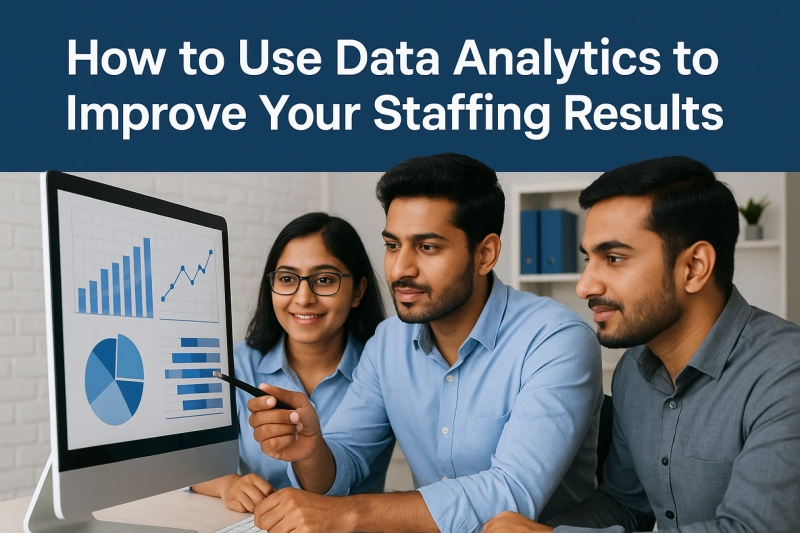Using Data Analytics to Improve Your Staffing Results
Searching for ways to improve internal business functions, especially vital ones like recruitment, is vital. Data analytics is one method they can use to utilize data they already have from their past and present workforce. An ineffective or costly staffing system can reduce turnover and profits, making it essential to use data, predict trends, and track real-time performance to make hiring decisions that benefit the company.
This article looks at the steps necessary to implement an effective data analytics system to boost recruitment.
Purpose of Data Analytics in Improving Recruitment
Over the years, the compilation and analysis of staffing data has aided recruitment. It's a step where companies must commit to collecting, analyzing, and arranging data relevant to the hiring process.
Undertaking these individual tasks will yield results that can lead to better decision-making, predictive hiring, and recruitment strategies that are measurable.
1. Improve Candidate Screening & Assessing
Preliminary screening starts with an analysis of candidate resumes and applications. This process is time-consuming, especially when there are hundreds of candidates to assess. It also focuses on the possibility of human error, avoidance of due diligence, and bias.
Using data from the initial step, the candidate's next assessment steps are:
- Skill Matching
Refined algorithms can match candidate skills with specified jobs based on skills. Skill matching enables the identification of applicants who qualify for a role.
- Keyword Identification
AI tools for recruitment can use complex natural language processing (NLP) algorithms that scan resumes for keywords or phrases that match details from the job descriptions.
It speeds up this vital initial step and ensures there's a valid reason for each candidate to progress to the next step.
2. Optimize Interviewing
The interview is a formal meeting needed to consider candidates and their suitability for distinct roles. Data analytics facilitates the process by:
- Interview Scheduling
AI and analytics can analyze recruiter and candidate schedules and set an interview at a time that suits both parties. This feature reduces delays, ensuring the process moves quickly.
- Analyzing Behavior
Video analysis enables recruiters to assess the candidate's suitability for a role based on their speech patterns, body language, and demeanor.
3. Enhance DEI Initiatives
As firms become more aware of the benefits of DEI efforts, ensuring hiring practices accommodate these efforts is essential. Data analytics aligns with these efforts and helps you achieve DEI goals by:
- Detecting Bias
Businesses can ensure fair recruitment by using algorithms to identify and mitigate any actions that may introduce bias into the process.
- Calculating Diversity Metrics
Analyzing a wide range of organizational and demographic data will improve diversity and inclusion efforts, ensuring the achievement of goals.
4. Employee Performance
Predicative analytics are essential in evaluating the candidate's performance.
- Performance Metrics
Analyzing company hiring data from previous staff helps to identify traits associated with high performance and quality output.
5. Improving Staff Retention
Studying employee data such as retention rates, overall job satisfaction, and average tenure duration aids in identifying the reasons why staff leave and adjusting retention strategies for success.
- Retention Predictions
Predictive models can assess the chances of candidates remaining in the company using factors such as previous job tenure, career status, and personal markers.
Steps to Implement Data Analytics in Recruitment
Leveraging data analytics requires firms to understand how to implement them seamlessly. Here are the steps that every top staffing firm in India uses.
1. Collect Relevant Staffing Data
The initial step is to gather any data relevant to staffing, including:
- Candidate data with applications, cover letters, resumes, portfolios, and social media profiles.
- Recruitment statistics of cost-per-hire, time-to-hire, hiring source, and rate of acceptance.
- Staff data of performance reviews, average tenure, promotions, and exit interviews.
These details will form the base of the analysis and provide insightful details.
2. Process & Standardize Data
Once the collection of data files is complete, the data requires cleaning to ensure usability. To do this, firms must ensure:
- All data is in the same format and features clear structuring.
- Identification and correction of all errors and removal of duplicates.
- Merging data from every internal source establishes a rich dataset.
3. Analyze Data
Upon data standardization, firms can analyze the details using these methods:
- Descriptive analytics, which summarizes all data to extract patterns and trends.
- Prescriptive analytics relies on statistics and ML to predict future recruiting outcomes.
- Predictive analytics gives firms in-depth guidance on hiring through forecasts.
4. Generate Reports
After completing the data visualization, it's critical to represent the data in a form that's easy to present to managers and stakeholders:
- Reports
Presenting detailed reports with transparent insights, recruitment metrics, and real-time trends will aid decision-making.
- Dashboards
Allowing access to interactive dashboards is one way to distribute information about recruitment metrics and trends, allowing for faster hiring decisions.
Conclusion
Companies that choose to prioritize and utilize data analytics will fare better than those that don't. It's a powerful way to use data to gain insights, optimize recruitment, and hire qualified candidates who meet role requirements.
Using data analytics allows firms to achieve DEI goals, eliminate bias, reduce screening time, and improve interviewing. Companies who need help using data analytics can hire the best staffing agency in India for expert assistance.


